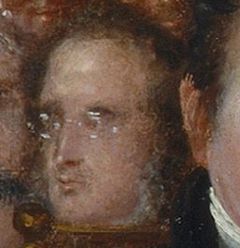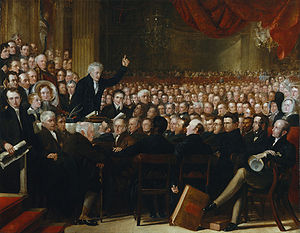- Constantine Richard Moorsom
-
Constantine Richard Moorsom 
Moorsom at the 1840 Anti-Slavery ConferenceBorn 22 September 1792[1]
High Stakesby, Whitby, North Riding of Yorkshire[1]Died 26 May 1861[2]
Russell Square, London[1]Resting place Kensal Green Cemetery[3] Nationality English Occupation Royal Navy Vice-Admiral Known for Innovation Spouse Mary Children many Parents Robert and Eleanor Moorsom Relatives William Moorsom Constantine Richard Moorsom (1792–1861) was a Vice-Admiral in the Royal Navy. He commanded HMS Fury a Hecla-class bomb vessel which saw wartime service in the Bombardment of Algiers, an attack on Barbary pirates at Algiers in HMS Fury in August, 1816.[4] Moorsom was the son of Admiral Sir Robert Moorsom, a veteran of Trafalgar. Moorsom was on the roster of HMS Revenge, his father's ship, when it was at the Battle of Trafalgar. However records show that Constantine was actually at school at the time of the battle.[1] Moorsom rose to be chairman of the London & North Western Railway.[2]
Contents
Biography
Early life
Moorsom was born on 22 September 1792, the son of Admiral Sir Robert Moorsom who was to be a Knight Commander of the Bath and a veteran of the Trafalgar. His mother was born Eleanor Scarth.
Moorsom entered the Royal Navy College in Portsmouth where he was awarded a first medal and three prizes for mathematics. His service was noted by not only his progression but the record of his innovation. Moorsom's younger brothers also joined the navy. Henry Moorsom was killed in 1826 whilst in command of the sloop William Scarth Moorsom left the navy in 1832 and became a successful railway engineer after training with Robert Stephenson. It is said that the brothers inherited their fathers talent for drawing and poetry.[6] His sister, Maria Margaret, married in 1815 and had seven children with the Rev. Longueville Massell.[5] His naval career started with his first posting to HMS Revenge which at the time was in the Atlantic off Portugal. The ship was involved in the defence of Cadiz. He became a lieutenant in 1816 after returning to England on board HMS Warspite. He was then with HMS Superb until 1814 when he was rewarded with his own command of a sloop at Bermuda - HMS Goree. He was with the boat a year then another year with HMS Terror, before taking on the bomb vessel, HMS Fury.[1]
He commanded HMS Fury, a Hecla-class bomb vessel, in the Bombardment of Algiers, an attack on Barbary pirates at Algiers in August, 1816.[4] As a result of the bombardment slaves were released and Moorsom's use of his vessel was put under investigation. It was found that the Fury had fired twice as many mortars as any other boat and that this was due to the fitting which Moorsom had devised. His methods were adopted as standard practice.[1]
Moorsom became a post captain in 1818 and in 1822 his innovation came again to notice when he was put in command of Chatham. He took no further sea missions but rose through the ranks to rear-admiral. In 1843 he published an essay on the Principles of Naval Tactics which he updated three years later.[1]
Abolitionist
Moorsom is below the main speaker's raised shoulder in the painting, which is of the 1840 Anti-Slavery Convention.[7] Move your cursor to identify him or click icon to enlarge
In 1840, Moorsom attended the World Anti-Slavery Convention in London. It was held at the Freemasons Hall on the 12 June 1840[8] The meeting was attended by leading abolitionists from around the world. The portrait above is taken from the commemorative painting where he can be seen behind the head of Joseph Sturge of the Anti-Slavery International, who organised the conference. The painting hangs in the National Portrait Gallery.
Railways
Constantine also went into the railway business as company secretary at the same company where his brother, William, was engineer. He was elected to the board of the Birmingham and Gloucester Railway in 1841 and almost immediately became its chairman. He remained in this position until his resignation just before the company became part of the Midland Railway in 1843.[9]
He served as a director of the London & Birmingham Railway from 1837 to 1839. He was promoted on 29 August 1851 to be a Rear-Admiral of the Blue.[10] From 1852 until the time of his death on 26 May 1861, he was chairman of the London & North Western Railway.[2][9] During this time he also chaired a committee for the British Association on steamship performance. He died at Russell Square in London after becoming a vice admiral in 1857 and having fathered a large family with his wife Mary Maude of Silaby Hall in Durham.[1]
References
- ^ a b c d e f g h Moorsom in Dictionary of National Biography, Sidney Lee, accessed 19 Nov 2008.
- ^ a b c Document summary, Salford University, accessed 18 November 2008
- ^ Kensal Green Publications, accessed 18 November 2008
- ^ a b The Life of Admiral Viscount Exmouth, Edward Osler, p429, 1835
- ^ a b Obituaries, Gentleman's Magazine, p322, accessed 18 November 2008
- ^ Jehanne Wake, Kleinwort, Benson: the history of two families in banking, p.89, accessed 18 November 2008
- ^ The Anti-Slavery Society Convention, 1840, Benjamin Robert Haydon, 1841, National Portrait Gallery, London, NPG599, Given by British and Foreign Anti-Slavery Society in 1880
- ^ The history of Anti-Slavery International, accessed 19 November 2008
- ^ a b LNWR People, London and North Western Railway Society, accessed 18 November 2008
- ^ London Gazette: no. 21240. p. 2206. 29 August 1851. Retrieved 2008-11-21.
Categories:- Royal Navy admirals
- People from Whitby
- 1782 births
- 1861 deaths
- British people of the Barbary Wars
- Burials at Kensal Green Cemetery
- British abolitionists
- Directors of the London and North Western Railway
Wikimedia Foundation. 2010.

